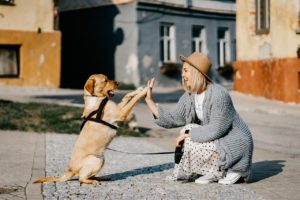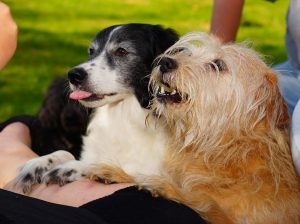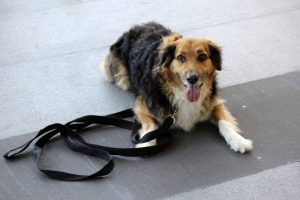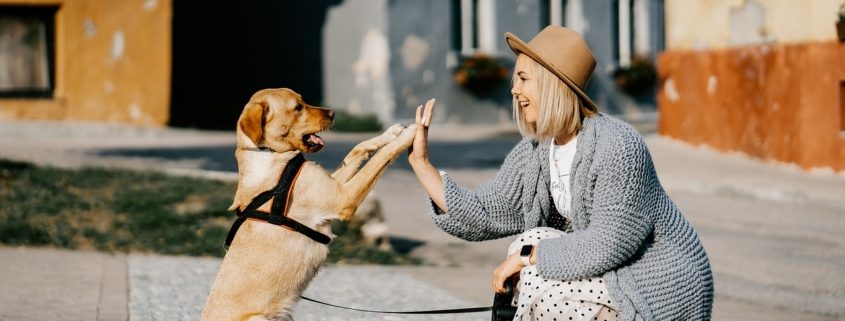Ask Crystal: Protective Dog Keeps Owner to Self

Dear Crystal,
I have a miniature poodle that I have trained from 10 weeks. Circumstances meant that he spent a LOT of time with me in the first two years and he’s very attached now. Mostly, this is good. Negatively, it means he can be protective and be aggressive towards other dogs that show an interest in me. I’d like to reduce this behavior, naturally. Any suggestions?
Another related situation is how he responds to my dad’s dog, who I also raised for her first couple years. She is a 9-year-old golden retriever and my poodle can get aggressive with her for, I suspect, the same reasons, though much, much less often after getting familiar with the larger dog. I could use some advice reframing that relationship between the golden and the mini poodle as well, not just between the poodle and random dogs.
Thanks,
Peacekeeper
Dear Peacekeeper,
Dog-dog aggression is certainly an upsetting behavior to witness and a lot of times it comes up unexpectedly. While I don’t know what is going on exactly without seeing it, I can give you some suggestions for narrowing down what the cause might be and some methods that should help regardless of what the cause of the behavior is.
People often use the word protective when describing their dog’s aggressive behavior towards either dogs or people. In my experience, it is more likely one of two things. The dog may be guarding you from other dogs rather than trying to protect you. You are the source of all the is good and wonderful and they do not want anyone to take that away.
The other cause is fear. It would be good to know if the behavior occurs in all situations, only on leash, off leash, in the home only, off property only etc. Does he only do it with dogs that show an interest? What does showing an interest look like? How far away does he begin to display the behavior? What exactly does the behavior look like? Is it all dogs or only the two you mentioned? These are questions that need to be answered in order to start helping him.
Aggression is caused by stress. The more stressors the dog is exposed to, the more likely he is to act out aggressively. Make a list of anything that you notice him displaying stress or fear at. We need to make a concerted effort to avoid his triggers as much as possible to help him.
We always start with management and preventing his exposure to his triggers. If a trigger is being approached while he is on leash, stop all on leash greetings. I personally am not a fan of on leash greetings for dogs while out on walks. Many dogs become reactive or aggressive when on leash because they have lost their ability to get away from the other dog if they are afraid. You take away the flight ability and that may force the dog to choose fight. There are dogs that look very aggressive on leash but are totally friendly off leash. We must always remember the dog’s right to choose their interactions in life.
Become a student of dog body language so you can learn what signals he gives before he progresses to the aggressive behaviors. Here are some possible signals a dog may give if he is feeling fearful or stressed; lip licking, yawning, looking away, stiff body, high flagging tail, tucked tail, limp tail, ears back, mouth closed, quick stiff movements, body weight backwards and/or hard eyes. A happy relaxed dog is loose and a dog that is stressed is stiff and tight in all aspects of their body. If you can see these signs, move the dog away from the trigger until he is at a distance where he is relaxed.
 It’s important to establish what a realistic goal is for your dog. I think him being to coexist with the Golden is likely an obtainable goal. Having him behave calmly on leash when he sees another dog, is obtainable. Getting along with every single dog he meets may not be realistic but if you can recognize his signs of discomfort sooner you can get him out of situations before it escalates. Maybe he is a dog that is not really interested in playing or meeting new dogs. If that’s the case, I would say just work on getting him used to dogs he needs to interact with like family member’s dogs.
It’s important to establish what a realistic goal is for your dog. I think him being to coexist with the Golden is likely an obtainable goal. Having him behave calmly on leash when he sees another dog, is obtainable. Getting along with every single dog he meets may not be realistic but if you can recognize his signs of discomfort sooner you can get him out of situations before it escalates. Maybe he is a dog that is not really interested in playing or meeting new dogs. If that’s the case, I would say just work on getting him used to dogs he needs to interact with like family member’s dogs.
A good way to test if the owner is the cause of the behavior is to remove the owner and observe the dog’s behavior with these dogs. You could set up a cheap camera and have a friend handle your dog while you are in another room or off the property. If it is the owner, then we usually won’t see the behavior when the owner is not present.
If you are the cause of the behavior, then we would treat it with a resource guarding protocol. These training protocols are designed to change the dog’s opinion about another dog approaching you. We also want to teach him an alternative behavior to do when a dog approaches. I would suggest contacting a professional trainer if that is the case because it can be complicated to work with on your own.
You mention he does better with the Golden when given a longer introduction and it may be then that your dog just needs more time to get used to another dog. Puppies are very social with other dogs but as dogs age they tend to become more and more selective with playmates. Some dogs don’t want to play or interact with other dogs at all. They shouldn’t have to if they don’t want to.
A good way to work on his relationship with the Golden is to start off with a tandem walk with the two dogs maybe in the neighborhood or a park so that it is more neutral territory so that if territorial behavior is included, we can try to eliminate that aspect. Have a handler for each dog. I often start off with one dog in front of the other and follow that dog. The dogs should be far enough away so that they are relaxed. If any stiffness or signs of discomfort come up, get some more distance. If they aren’t relaxed, we don’t want to let them meet. We just keep walking as close as they are comfortable with. Feed your dog treats for offering eye contact, walking next to you, being calm. If he gets too close, call him back and feed a treat.
When I bring a new dog home, if the dogs are struggling to get used to each other, I do this walk daily but do it as much as you can. You should see the dogs start to have a more relaxed posture around each other and eventually be able to let them approach for a quick 3 second greeting and then keep moving.
One idea I have learned about recently is having parallel enrichment yards. Enrichment yards are small fenced in areas with a variety of enrichment toys for the dogs to play with. Each dog is walked around the yard to play with the toys. You have one dog in each yard at the same time doing an enjoyable activity and that can help them develop more positive feelings about that dog and become more relaxed around it.
You can then start working on the dogs around your house. Maybe you walk them around your yard together or sit in the backyard with each dog on a leash. Keep the dogs far enough away so that they are relaxed and offer treats for looking at the other dog, looking at you and just being calm in general. You should be able to sit closer and closer with time as they grow comfortable. The time scale is entirely up to the dogs. It could go quickly with just a few walks or it may take a month or more.
When you progress to working inside the house, there are some different options. You can sit on opposite sides of the living room with each dog on leash and reward for calm behavior just like in the backyard. You can have one dog behind a baby gate and walk the other dog up as close as you can with him remaining relaxed and feed each dog treats for looking at the other dog. If either dog growls or shows discomfort, back up until you are at a distance they can handle. When you aren’t actively training, have the door shut or the baby gate covered with a blanket to prevent them seeing each other.
 When you progress to the dogs being loose in the house together, let them drag leashes so you can easily separate if you see any tension. Ideally, you each call your dog away and reward with a treat for them coming over. Pick up any high value toys to avoid any unnecessary tension. Make them take breaks frequently like every couple of minutes at first. Avoid small confined spaces like doorways, hallways, stairways until they are comfortable as that can cause tension and disagreements.
When you progress to the dogs being loose in the house together, let them drag leashes so you can easily separate if you see any tension. Ideally, you each call your dog away and reward with a treat for them coming over. Pick up any high value toys to avoid any unnecessary tension. Make them take breaks frequently like every couple of minutes at first. Avoid small confined spaces like doorways, hallways, stairways until they are comfortable as that can cause tension and disagreements.
The idea is for the dogs to have a positive experience every time the other dog is around and to keep them at levels which they are relaxed and comfortable the entire time. One bad experience can really set you back so don’t try to rush anything. You can never go too slow but you can go too fast.
Consider hiring a Professional Certified Trainer to come out and watch the dog and look for those body language signs that the dog is uncomfortable. We have spent many hours watching dogs so we can usually see things that others cannot. They will formulate a training plan based on what they see and coach you along the way as road bumps come up. Locate one here: https://www.ccpdt.org/dog-owners/certified-dog-trainer-directory/
It does take time to change a dog’s feelings about something. The older they are the longer they have been practicing the behavior, the harder to change it is. However, if it is really important to you, work hard and I bet you will start to see improvement and get to a place you feel ok about with him. Good luck!
Until next time,
Crystal
Submit your own pet behavior question for Crystal here:







